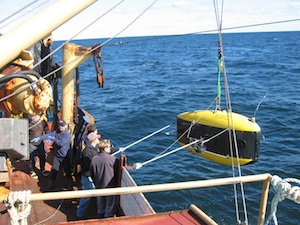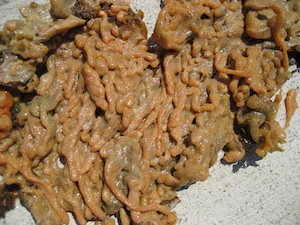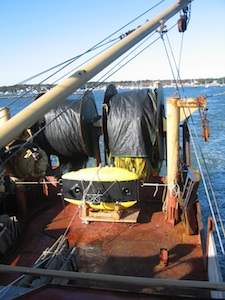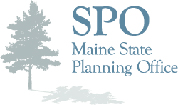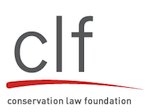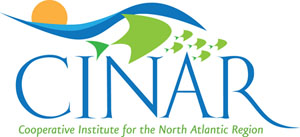Once described as “pancake batter poured over the seafloor” by University of New Hampshire researcher Dr. Larry Harris, the invasive species Didemnum vexillum, commonly called sea squirt, seems to be here to stay in the Gulf of Maine, at least in the short term.
Though this non-native tunicate (a group of underwater saclike filter feeders) has been observed in the Gulf of Maine for more than 10 years, monitoring its spread through nearshore and offshore regions and understanding its ecosystem impacts has been a challenge for scientists like Harris and Dr. Judith Pederson of the Massachusetts Institute of Technology (MIT) Sea Grant College Program. Tricky logistics is largely to blame.
Recovering the AUV aboard the F/V Isabella and Eva is a six person operation. Photo by R. G. Feeney.
Pederson is leading a study, with funding from the Northeast Consortium, to learn how best to monitor for sea squirt presence in potential habitats. She and MIT engineers teamed up with commercial fisherman Capt. Troy Dwyer to test the performance of an autonomous underwater vehicle (AUV) aboard his boat, F/V Isabella and Eva. During the summer of 2009 and into 2010, a number of engineering glitches have been overcome and the AUV has been taking high quality images of the ocean floor as it cruised along the bottom at depths up to 50 meters.
In all of the cruises on Stellwagen Bank and in areas offshore in Massachusetts Bay though, “we didn’t find any Didemnum” explains Pederson, “but that doesn’t mean that this invasive isn’t there.” The sea squirt has been documented along the New England coast and on Georges Bank for several years, but it is curious why it has not been seen in the area in between.
Part of the challenge of capturing still images of Didemnum is that this approach to monitoring is a bit of a “shot in the dark” and has its limitations for broad assessments of sea squirt presence and impacts. Thus, Pederson and colleagues have several spin-off projects, funded by the Northeast Sea Grant Programs and MIT Sea Grant including the development of spectral sensors that, in coordination with visual imaging, will likely be a more efficient approach. She is also collaborating with Dr. Scott Gallagher of Woods Hole Oceanographic Institution, who is refining a remotely operated vehicle for sea squirt detection.
Didemnum vexillum. Photo by G. Lambert.
The first quantitative coastal survey for non-native species, including Didemnum is taking place this summer from Rhode Island to Maine. “We will be looking for tunicates and other species on floating docks and pilings and will see if we can use another MIT Sea Grant AUV in shallow waters,” explained Pederson. The surveys involve taxonomists from all over the world, and are made possible with funding from state agencies and several Northeast estuary programs.
Maneuvering around boulders, operating on batteries that get quickly drained, and the current lack of real-time imaging capabilities with AUVs to send images to researchers pose formidable obstacles, but are being addressed in several projects underway with funding from several sources.
Despite the technical challenges, Pederson and colleagues persevere to understand why the sea squirt is invading the Gulf of Maine and how it is impacting the ecosystem and marine fisheries.
The F/V Isabella and Eva sets out from Scituate, MA with the AUV for a day of research. Photo by R. G. Feeney.
Rachel Gallant Feeney is the Communications and Information Coordinator for the Northeast Consortium, a collaborative research funding program founded in 1999 and based at the University of New Hampshire. www.northeastconsortium.org.
Print
